
Chase Hill Farm in Warwick feels like one of the most peaceful places on earth. It’s on one of those roads where you look twice when a car happens to drive by. There’s a view of Mount Monadnock across the fields to the northeast. Brown and white cows are usually to be seen grazing on one of the hillsides. A mysterious little doorway—the entrance to the cheese cave, it turns out—leads into the side of a hill. The only disruption is from the sheepdog who comes to meet you, but when Mark Fellows appears in response to her barking, he simply advises, “The best way to get her to stop is just to ignore her.”
The calm is partly a reflection of the farm’s location. But it’s also something that has been achieved gradually over the three decades since Mark and his wife Jeannette took over his parents’ business. Slowly and thoughtfully, they’ve been disentangling what was once a conventional commercial dairy from the surprisingly complex processes that have made cow’s milk one of the most fully industrialized of food products. At the same time, they’re part of a new partnership between farmers and land conservationists, a relationship that was by no means always amicable.
The Fellows—mother Vida, father Archie, and a growing number of children—came to Warwick sometime around 1920. Some family members had been working in the factories in Orange, but they took up farming in their new home, first at “Mayo’s Corners” where Athol and Richmond Roads cross, and then on Chase Hill Road just north of the current farm.
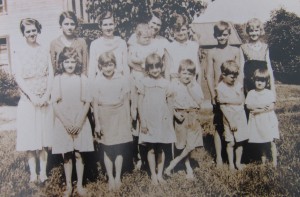
It was not the best of times to be a farmer in a hill town like Warwick. Thanks to more intensive farming methods, New England’s overall agricultural output actually expanded all the way through the 19th century, not peaking until 1910.[1] But approaches that worked on prime lowland farms were not suited to thinner upland soils. In an effort to keep up with the pressures of expanding commercial markets, many hill town farmers drastically cleared and overused land that was formerly wooded or kept as permanent pasture. The lumber industry that made up a sizeable portion of the area’s economy also contributed to erosion and depletion of hilly fields, sparking a movement for land conservation and calls to let the uplands return to forest. The largely-denuded Mount Grace was purchased in 1915 as part of the new state forest system,[2] and after the start of the long agricultural depression that followed World War I—prelude to the Great Depression of the 1930s—more and more old Massachusetts farms became public lands and new-growth forests.
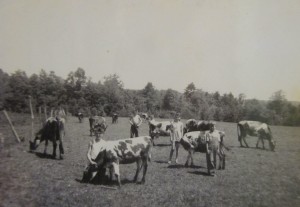
But not everyone was ready to give up on farming in Warwick. The town elected its first Director of Agriculture in 1919,[3] and the arrival of the Fellows family around that time suggests that some people were seeing the old fields as opportunities rather than problems. Archie and Vida’s large family—eventually there were 14 children—provided an in-house labor force, and there was a living to be made in the active network of small local dairies that supplied area towns with milk.
Archie and Vida’s marriage eventually failed, but Vida and the children stayed on the farm. Not only that, but her second-oldest son, Winfred, harbored dreams of starting a new farm. Like many farm children, he raised animals of his own from an early age. And like many of his siblings, he completed some of his high school training at New Salem Academy, 15 miles away, where an agricultural studies program inspired many local youth to pursue farming. After graduating, he acquired a small herd of Guernsey cows and made plans to build a new farmstead on the hillside next to his parents’ home.
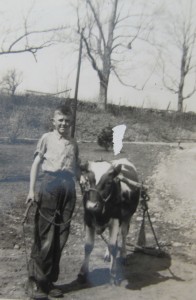
World War II intervened. 20-year-old Winnie Fellows was drafted in 1942 and lost his life in Germany two years later. He had entrusted his herd to his next-oldest brother, Oliver, and it was Oliver, with his wife Virginia, who eventually purchased the acreage from Vida and built the house and barn that stand on the property today. They farmed it from the mid-1950s to the early 1980s, raising their five children and selling their milk to regional bulk distributors.
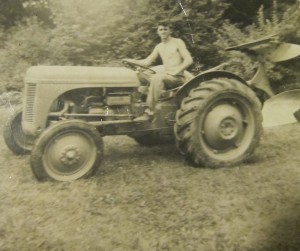
It was an exceptional thing for a young couple to start a new farm in a north-central Massachusetts hill town in the middle of the 20th century. It went against all the trends of old fields continuing to revert to forest or being sold for housing developments, young people moving into towns and cities for work, and food being distributed over longer distances on expanded postwar highways that let refrigerated trucks travel between source and supermarket with petroleum-powered ease. Town historian Charles Morse reported that the Director of Agriculture “had lost his enthusiasm from lack of interest and the town refused to elect one in 1941.”[4] Yet Winfred Fellows’ hopes for a farm in the 1930s and 40s, and Oliver and Virginia’s realization of those hopes in the 50s, show us that we need to look carefully at the many ways farmers have found to maneuver within the trends and sometimes to push back against them.
By the early 1980s, when Mark and Jeannette Fellows bought Chase Hill Farm from his parents, dairying in the area was shrinking fast. Consolidation in the milk distribution industry, among other factors, made it difficult or impossible to stay solvent below a certain scale. Mark had been trained at Cornell University to follow a conventional path into farming, but quite quickly he and Jeannette found that they didn’t want to be driven by conventional marketplace logic. Experimentally, one step at a time, they began to set the farm on a different footing.
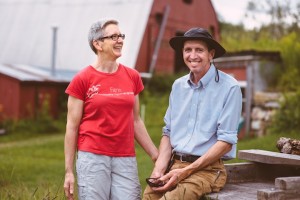
In hindsight, the basis of their strategy is very simple: keep costs of production low and produce as much as possible of what they need themselves. In practice, this has meant embracing an idea that has steadily gained currency among farmers practicing “regenerative” and pasture-based agriculture: that healthy grass is the foundation for just about everything else that happens on the farm. The 40 cows at Chase Hill eat fresh grass seven months of the year and dried grass—hay—in the winter months, grown on Chase Hill’s own fields plus some owned by neighbors.
“That whole thing is basically a solar panel,” Mark says, pointing to a hillside whose soils were deemed “marginal” by earlier generations of farm agencies and advocates. More literal solar panels on the barn supply more than half the farm’s electrical needs, and three draft horses provide a good deal of the energy for spreading manure and making hay, further minimizing the need for petroleum products.
Hay alone is not nutritious enough to support a cow who is producing milk. The usual solution is to grow or purchase corn so that cows can be milked year-round, but Chase Hill Farm went the other way. Mark began breeding and milking the cows only seasonally and letting them go “dry” in the winter, historically the pattern in this region before new technologies like silos for grain storage enabled year-round dairying starting in the early 20th century. Industrial agriculture demands standardization and a steady, predictable product; seasonal dairying is more of a dialogue between farmers’ plans and the limits of what can be produced without undue stress by human and animal bodies, and by the land that supports them.
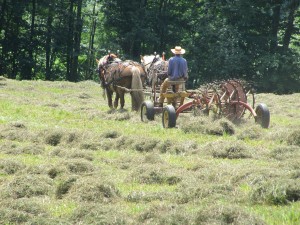
Two final pieces of the puzzle have helped turn Chase Hill Farm even farther toward self-sufficiency. First, Mark and Jeannette stopped making the wholesale milk sales that provided the bulk of their income in the early days. Instead, they moved toward direct-marketing, another trend that is both new and very old. And second, Jeannette started to make cheese in 2001, adding value, variety, and year-round flexibility to the farm’s other offerings of meat and raw (unpasteurized) milk. A range of artisanal cheeses comes out through the mysterious little door in the hillside, to be sold at farmers markets, some area supermarkets, and in the farm’s small on-site store.
Another change in 2001 reflects a recent trend in land conservation: protecting farmland in perpetuity so that it remains in production. When the 75-acre Mayo’s Corner farm where Mark’s father had been born came up for sale, the Fellows were concerned that one of the few remaining farms in town was ripe for development into house lots. They also saw an opportunity to gain more control over the vital pasture and hayfield base that their farm depends on. They sold the development rights on their own 260-acre farm to the state, and with the proceeds of that sale plus the help of Mount Grace Land Conservation Trust, they were able to buy the old farm at the crossroads.
Warwick’s historian, Charles Morse, was caustic about the role of the state in transforming so much of the town’s farmland into forests. The state, he declared in his 1963 history, had “gradually devoured nearly one-third of the town bite by bite” while the majority of the population “bowed to the inevitable.”[5] But protecting farmland charts a middle course between taking land out of active use and letting purely financial considerations decide its future. It’s an approach that resonates with Mark and Jeannette Fellows’ quiet but determined resistance to the logic of the industrialized food system, and their ongoing work of building a thriving business at its very edges.
NOTES
[1] Michael M. Bell, “Did New England Go Downhill?” in Geographical Review, Vol. 79, No. 4 (October 1989), p. 464.
[2] Charles Morse, Warwick, Massachusetts: Biography of a Town (Cambridge: Dresser, Chapman, and Grimes, 1963), p. 179. On the development of state forests in general, see “Massachusetts State Forestry Programs,” William H. Rivers, in Stepping Back to Look Forward: A History of the Massachusetts Forest, Charles H.W. Foster, ed. (Petersham, MA: Harvard Forest, 1998, pp. 147-219).
[3] Morse, Warwick, Massachusetts, p. 179.
[4] Morse, Warwick, Massachusetts, p. 180.
[5] Morse, Warwick, Massachusetts, p. 180.